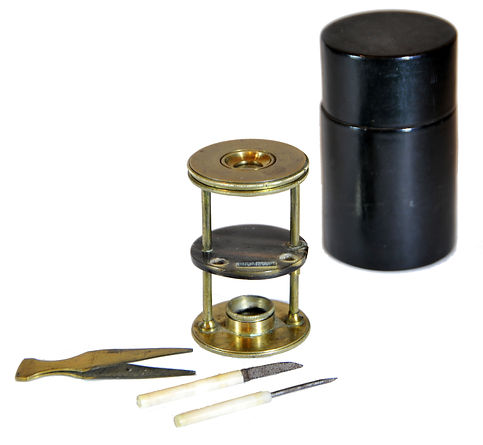

Withering-type botanical microscope, 1780
The “Withering-type Microscope” is named for its inventor, Dr. William Withering (1741-1799), an English physician and botanist who graduated with a degree in medicine 1766 in Edinburgh. Inspired by the taxonomical work and systematic classification of Carl Linnæus (1707-1778), Withering (1776) applied the Linnaean taxonomical system of classification to British plants in a seminal, two volume work, A Botanical arrangement of all the vegetables naturally growing in the British Isles. The earliest reference to a small botanical microscope of Withering’s design appeared in the first edition of this book. There, Withering indicated this microscope was developed for field dissections of flowers and other plant parts. While there is no surviving example of this exact design, close relatives of this type do exist, made either completely of brass or of ivory with brass pillars. Ivory models can be tentatively dated to 1776-1785, as by 1787 a newer model with a hollowed stage in an all-brass configuration already predominated. In turn, it was preceded by the brief appearance of a transitional brass model but with solid stage of ivory or horn (seen here). This version is extremely rare and must have been produced in very small numbers. By 1787 all these varieties were not recorded anymore in the literature.

Withering-type botanical microscope, 1780
The “Withering-type Microscope” is named for its inventor, Dr. William Withering (1741-1799), an English physician and botanist who graduated with a degree in medicine 1766 in Edinburgh. Inspired by the taxonomical work and systematic classification of Carl Linnæus (1707-1778), Withering (1776) applied the Linnaean taxonomical system of classification to British plants in a seminal, two volume work, A Botanical arrangement of all the vegetables naturally growing in the British Isles. The earliest reference to a small botanical microscope of Withering’s design appeared in the first edition of this book. There, Withering indicated this microscope was developed for field dissections of flowers and other plant parts. While there is no surviving example of this exact design, close relatives of this type do exist, made either completely of brass or of ivory with brass pillars. Ivory models can be tentatively dated to 1776-1785, as by 1787 a newer model with a hollowed stage in an all-brass configuration already predominated. In turn, it was preceded by the brief appearance of a transitional brass model but with solid stage of ivory or horn (seen here). This version is extremely rare and must have been produced in very small numbers. By 1787 all these varieties were not recorded anymore in the literature.
References: SML: A242712; Goren 2014.
References: SML: A242712; Goren 2014.
Prof. Yuval Goren's Collection of the History of the Microscope
The Compass Microscope, 1700-1830
The "Compass Microscope" is named so because of the center hinge, reminiscent of a drafting compass. It was used during the 18th century for inspecting small opaque objects such as fauna or flora. To use the instrument, the user would mount the specimen with the stage forceps and locate it just opposite the lens. The silvered reflecting Lieberkuhn mirror focuses more light on the top surface of the specimen. These microscopes were very popular as pocket field aids for naturalists.
Two Compass Microscope Sets, circa Mid-18th Century
These are typical brass compass microscopes from the early to mid-18th century. They feature brass bodies with turned ivory handles, sliding and pivoting specimen holders, forceps, and a live box that opens on a screw hinge to accommodate small specimens. The microscopes are equipped with various Lieberkühn eyepieces, which include early turned horn or brass inserts to secure the lenses in place. Additionally, they come with brass tweezers, and the larger instrument includes a small cylindrical "talc box" that holds mica cover discs.
These are typical brass compass microscopes from the early to mid-18th century. They feature brass bodies with turned ivory handles, along with sliding and pivoting specimen holders, forceps, and a live box that opens on a screw hinge to accommodate small specimens. The microscopes are equipped with various Lieberkühn eyepieces, which include early turned horn or brass inserts to secure the lenses in place. Additionally, they come with brass tweezers, and the larger instrument includes a small cylindrical "talc box" that holds mica cover discs.
Inv. YG-21-004
.jpg)
This type of compass microscope appears in the popular book by Henry Baker (1698-1774), The Microscope Made Easy (1743), as a microscope for opaque objects. Using the compass microscope as a basis for the design, this microscope incorporated a hinged focusing system with a reflector or speculum that reflects light upon the object making it possible to examine opaque as well as translucent specimens. The parts and functionality are explained further in chapter VII, entitled "Of the microscope for opake [opaque] objects." Baker's book popularized the microscope in the 18th century.


INV. YG-21-004
© Microscope History all rights reserved


Inv. YG-25-008
French Compass Microscope, late 18th to early 19th Century
This late 18th-century compass microscope is often considered to be French. It elaborately features two lieberkuhns, each one having a different lens, which enables the examination of the object under different magnification. It comes with ebony-turned handle.
_JPG.jpg)

Inv. YG-21-006

© Microscope History all rights reserved
© Microscope History all rights reserved